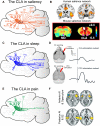Human lesions and animal studies link the claustrum to perception, salience, sleep and pain
- PMID: 35348621
- PMCID: PMC9166552
- DOI: 10.1093/brain/awac114
Human lesions and animal studies link the claustrum to perception, salience, sleep and pain
Abstract
The claustrum is the most densely interconnected region in the human brain. Despite the accumulating data from clinical and experimental studies, the functional role of the claustrum remains unknown. Here, we systematically review claustrum lesion studies and discuss their functional implications. Claustral lesions are associated with an array of signs and symptoms, including changes in cognitive, perceptual and motor abilities; electrical activity; mental state; and sleep. The wide range of symptoms observed following claustral lesions do not provide compelling evidence to support prominent current theories of claustrum function such as multisensory integration or salience computation. Conversely, the lesions studies support the hypothesis that the claustrum regulates cortical excitability. We argue that the claustrum is connected to, or part of, multiple brain networks that perform both fundamental and higher cognitive functions. As a multifunctional node in numerous networks, this may explain the manifold effects of claustrum damage on brain and behaviour.
Keywords: claustrum; lesion; pain; perception; salience; sleep.
© The Author(s) 2022. Published by Oxford University Press on behalf of the Guarantors of Brain.
Figures



References
-
- Atlan G, Terem A, Peretz-Rivlin N, Groysman M, Citri A. Mapping synaptic cortico-claustral connectivity in the mouse. J Comp Neurol. 2017;525(6):1381–1402. - PubMed
-
- Goll Y, Atlan G, Citri A. Attention: the claustrum. Trends Neurosci. 2015;38(8):486–495. - PubMed
-
- Hoover WB, Vertes RP. Anatomical analysis of afferent projections to the medial prefrontal cortex in the rat. Brain Struct Funct. 2007;212(2):149–179. - PubMed
Publication types
MeSH terms
Grants and funding
LinkOut - more resources
Full Text Sources
Research Materials

